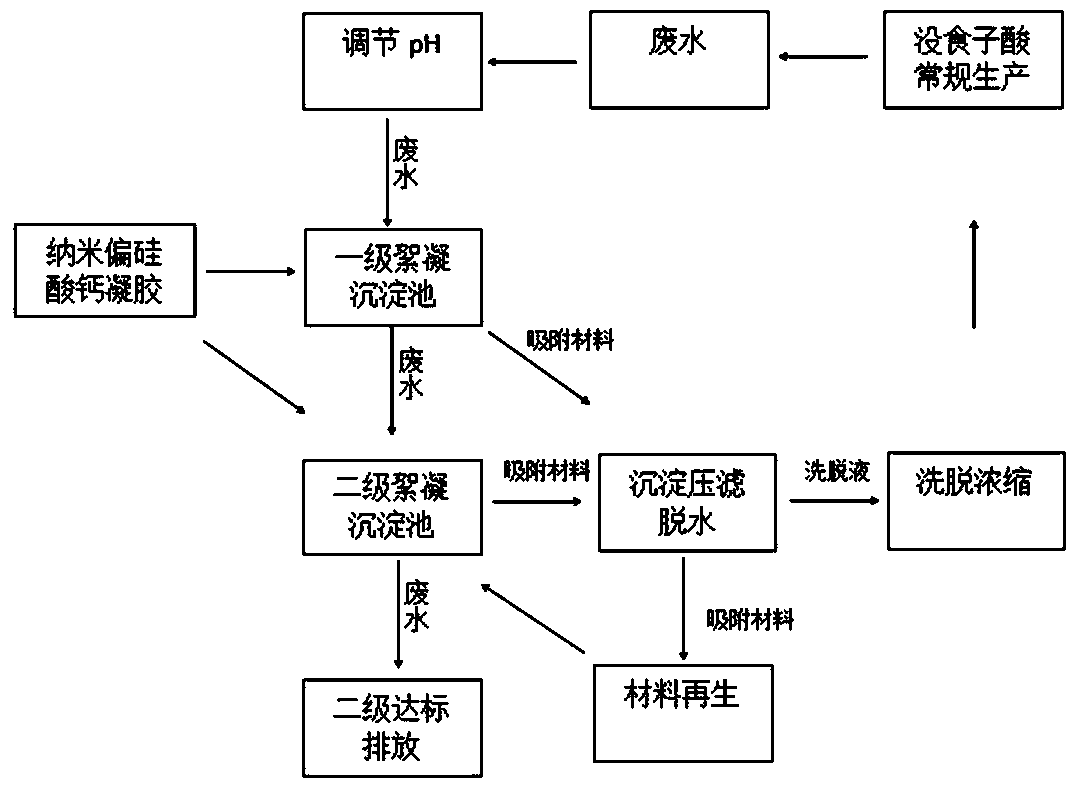A method for purifying and treating waste water produced by gallic acid with nano-silica gel
A technology for gallic acid and waste water production, applied in chemical instruments and methods, flocculation/sedimentation water/sewage treatment, natural water treatment, etc., to achieve the effect of simplified process, simplified resource recovery and low cost
- Summary
- Abstract
- Description
- Claims
- Application Information
AI Technical Summary
Problems solved by technology
Method used
Image
Examples
Embodiment 1
[0022] Example 1: Treatment of processing wastewater from Galla Chinensis with the maximum dosage of nano silicone gel
[0023] pH value 1.41, gallic acid content 1.46%, salt content 10.21%, COD Cr The 28086 mg / L gall processing wastewater is adjusted to pH 10 with lime milk with a mass percentage concentration of 15% in the storage tank, and then introduced into the primary flocculation sedimentation tank. Add calcium metasilicate nano gel to the primary flocculation tank at a dosage of 50g / L, stir and absorb for 4 hours, and then settle for 2 hours. The wastewater treated by the primary tank flows into the secondary flocculation tank, and the amount of calcium metasilicate nanogel is 50g / L, stirred and adsorbed for 3 hours, and then precipitated for 2 hours. The removal rate of gallic acid is 93.57% for the wastewater purified and treated by this secondary flocculation tank, and the wastewater COD = 88.75mg / L.
[0024] Adjust the pH of the nano-silica gel sediment in the primary...
Embodiment 2
[0026] Example 2: Treatment of processing wastewater from Galla Chinensis with minimum dosage of nano-silicon gel
[0027] pH value 1.41, gallic acid content 1.46%, salt content 10.21%, COD Cr The 28086 mg / L gall processing wastewater is adjusted to pH 10 with lime milk with a mass percentage concentration of 15% in the storage tank, and then introduced into the primary flocculation sedimentation tank. Add calcium metasilicate nano gel to the primary flocculation tank at a dosage of 40g / L, stir and absorb for 4 hours, and then settle for 2 hours. The wastewater treated by the primary tank flows into the secondary flocculation tank, and the amount of calcium metasilicate nanogel is 40g / L, stirred and adsorbed for 3 hours, and then precipitated for 2 hours. The removal rate of gallic acid is 90.24% for the wastewater purified and treated by this secondary flocculation tank, and the wastewater COD = 94.46mg / L.
[0028] Adjust the pH of the nano-silica gel sediment in the primary or s...
Embodiment 3
[0030] Example 3: The optimal dosage of nano silicone gel is used to treat the processing wastewater of Chinese gall
[0031] pH value 1.41, gallic acid content 1.46%, salt content 10.21%, COD Cr The 28086 mg / L gall processing wastewater is adjusted to pH 10 with lime milk with a mass percentage concentration of 15% in the storage tank, and then introduced into the primary flocculation sedimentation tank. Add calcium metasilicate nano gel to the primary flocculation tank at a dosage of 50g / L, stir and absorb for 4 hours, and then settle for 2 hours. The wastewater treated by the primary tank flows into the secondary flocculation tank, and the amount of calcium metasilicate nanogel is 40g / L, stirred and adsorbed for 3 hours, and then precipitated for 2 hours. The removal rate of gallic acid is 92.26% for the wastewater purified and treated by this secondary flocculation tank, and the wastewater COD = 90.05mg / L.
[0032] Adjust the pH of the nano-silica gel sediment in the primary o...
PUM
 Login to View More
Login to View More Abstract
Description
Claims
Application Information
 Login to View More
Login to View More - R&D
- Intellectual Property
- Life Sciences
- Materials
- Tech Scout
- Unparalleled Data Quality
- Higher Quality Content
- 60% Fewer Hallucinations
Browse by: Latest US Patents, China's latest patents, Technical Efficacy Thesaurus, Application Domain, Technology Topic, Popular Technical Reports.
© 2025 PatSnap. All rights reserved.Legal|Privacy policy|Modern Slavery Act Transparency Statement|Sitemap|About US| Contact US: help@patsnap.com

